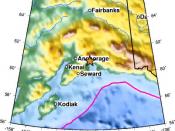Plate Boundary's
Alaska is positioned in a very unique and complex tectonic surrounding. Towards the southern edge of Alaska, lies the boundary between the North American Plate and the Pacific Plate. The Pacific Plate is moving towards the northwest and is being subducted under the North American Plate. The average rate of subduction at this boundary is 5-7 cm per year. This movement causes the crust in southern Alaska to become compressed and warped, with some areas along the coast being depressed and other areas inland being uplifted. Towards the southeastern edge of Alaska, the plate boundaries are made up of several strike-slip faults, these faults are known as the Queen Charlotte-Fairweather Fault System. These faults are some of the largest in the United States, and run through Canada and back into Alaska. Towards the eastern Gulf of Alaska the Yakutat block collides with Alaska. Towards the west, the Aleutian Megathrust subduction zone makes up the remaining part of the plate boundary in Alaska (http://www.giseis.alaska.edu).
Nature of Seismicity
By far the most seismically active state in the US, Alaska is home to about 12,000 earthquakes a year. The majority of this seismic activity occurs along the faults connected with the North American Plate and the Pacific Plates. The largest earthquakes recorded in the state have been caused by the subduction of the Pacific plate beneath Alaska. Three of the seven largest earthquakes occurring in Alaska in the 20th century have been as a result of this subduction. Although the occurrence of these great subducting earthquakes is rare, about one every hundred years or so, five large subduction earthquakes have occurred since 1938. In a recent analysis of Alaska's potential seismicity, researchers suggested that several subduction segments may be ready to rupture soon. As depicted in the...


